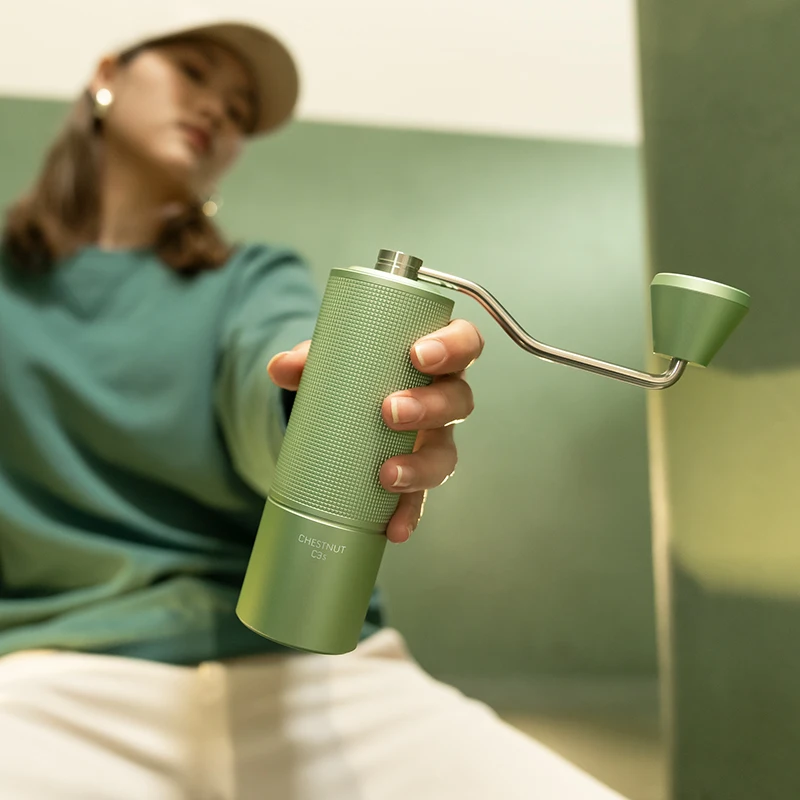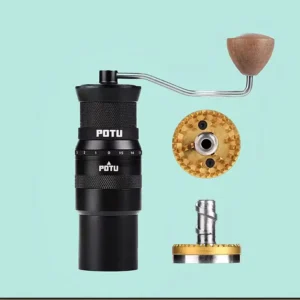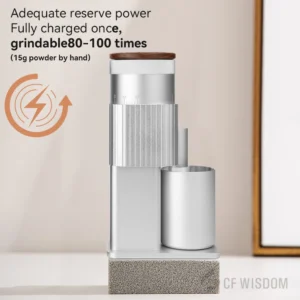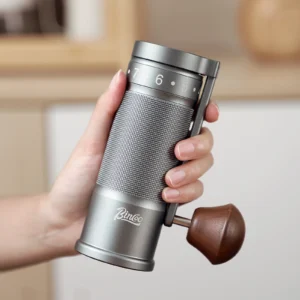Introduction: Why Burr Material Matters for Your Espresso
The journey to the perfect espresso shot begins long before water touches coffee – it starts with how you grind your beans. While many coffee enthusiasts invest thousands in high-end espresso machines, the truth is that your grinder’s burr material often has a more profound impact on your cup quality than the machine itself.
The material of your burr directly influences three critical aspects of your espresso:
- Grind consistency (which affects extraction evenness)
- Heat generation during grinding (which can alter flavor compounds)
- Durability (which determines long-term performance)
Consider this: even with perfect technique, inconsistent grinding can cause extraction rates to vary by 15-25%, dramatically altering flavor. This explains why a $500 machine paired with an excellent burr grinder can often outperform a $2,000 machine using an inferior grinder.
If you’ve ever experienced shots that taste perfect one day and sour or bitter the next despite using identical settings, your burr material might be the culprit. Understanding the fundamental overview of different burr materials will empower you to make better choices and achieve more consistent, delicious results.
Understanding Burr Fundamentals for Espresso
Burrs are the heart of any coffee grinder – two precision-engineered pieces that work together to cut coffee beans into particles rather than crushing them (as blade grinders do). They function by creating a narrow gap where beans are caught and precisely cut to a specific size.
For espresso, this precision is especially critical. Ideal espresso requires particles sized between 200-400 microns – finer than table salt but not quite powdered. This exacting requirement means that not all burrs are created equal.
Two primary burr designs dominate the espresso world:
- Conical burrs: Feature a cone-shaped inner burr that fits inside a ring-shaped outer burr
- Flat burrs: Consist of two parallel rings with cutting teeth that face each other
Espresso grinding differs substantially from other brewing methods because it demands:
- Ultra-fine particle size for proper resistance to pressurized water
- Exceptional consistency to ensure even extraction
- Minimal “fines” (dust-like particles that can cause channeling and bitterness)
The material from which these burrs are made significantly influences their ability to meet these demands. The detailed comparison of how different burr types function reveals that material choice affects everything from heat buildup to grind uniformity to flavor potential.
As we explore various burr materials, keep these foundational requirements in mind – they’re what separate adequate espresso from exceptional shots.
Steel Burrs: The Industry Standard for Espresso
Steel burrs have earned their place as the industry standard for espresso grinding through their balance of performance, durability, and precision. They generally fall into two categories:
Stainless Steel vs. High Carbon Steel
Stainless steel burrs offer superior corrosion resistance but slightly less edge retention, while high carbon steel burrs maintain sharpness longer but require more protection from moisture. Both perform admirably for espresso, though high carbon steel often appears in premium grinders where edge geometry is paramount.
Manufacturing Differences
– Machined steel burrs: CNC-milled for precision, with sharper edges and superior consistency
– Stamped steel burrs: Punched from steel sheets, less expensive but typically less precise
When it comes to espresso extraction specifically, steel burrs offer several advantages:
Pros:
– Excellent precision for consistent particle size
– Sharp cutting edges for clean cuts rather than crushing
– Good thermal conductivity to dissipate heat (though they do generate more initially)
– Enhanced flavor clarity and brightness in the cup
– More affordable than specialty materials
Cons:
– Generate more heat during grinding than ceramic
– Wear faster than coated alternatives (typically processing 500-1500 pounds before replacement)
– Can impart metallic notes if not properly maintained
– Higher friction during grinding
During operation, steel burrs may increase in temperature by 30-50°F, which can affect volatile compounds in coffee oils. This characteristic makes them less ideal for extended grinding sessions but perfectly suitable for home espresso preparation.
The durability and performance of steel burrs in high-volume settings reveal why they remain popular even with their limitations. Many specialty coffee professionals prefer steel for its ability to produce clean, bright espresso with excellent clarity.
For those seeking quality steel burrs designed specifically for espresso preparation, exploring grinders specifically designed for espresso can provide excellent insight into how these materials perform in practice.
Ceramic Burrs: Alternative Option for Espresso Grinding
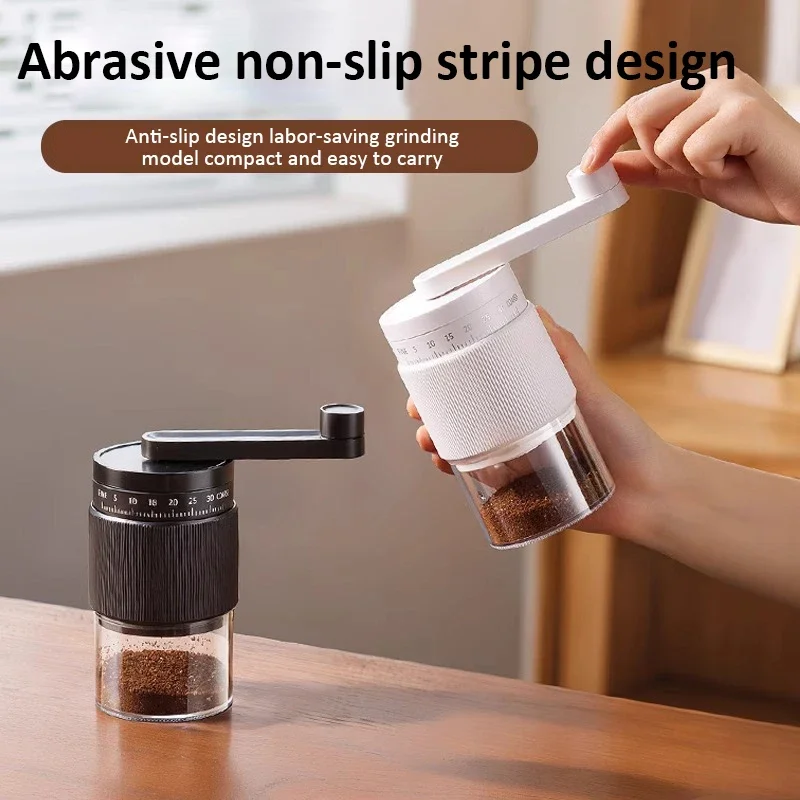
Ceramic burrs offer a compelling alternative to steel, bringing unique characteristics that can significantly influence your espresso experience. Modern ceramic burrs are typically made from zirconium oxide, an extremely hard material formed through a process of sintering (compacting and heating) ceramic powders to create durable grinding surfaces.
The primary advantage of ceramic for espresso lies in its thermal properties. Unlike steel, ceramic burrs:
Pros:
– Generate significantly less heat during grinding (up to 70% less than steel)
– Maintain temperature stability throughout extended grinding sessions
– Retain their edge longer (rated 8-8.5 on the Mohs hardness scale compared to steel’s 5-6)
– Produce espresso with enhanced body and richer mouthfeel
– Never rust or corrode, requiring less maintenance
– Often last 2-3 times longer than comparable steel burrs
Cons:
– More brittle and susceptible to cracking if foreign objects enter the grinder
– Typically produce slightly less uniform particle distribution
– Often create more fines, which can lead to over-extraction
– Usually more expensive than basic steel options
– Slower grinding speed in many implementations
When brewing espresso, ceramic burrs tend to excel with darker roasts where body and rich chocolate notes are desired. The thermal stability means less heat transfers to the beans during grinding, preserving volatile oils that contribute to aromatic complexity.
For home baristas who only make a few shots per day, detailed analysis of heat management in different burr materials suggests ceramic offers practical advantages. The heat differential between ceramic and steel becomes particularly noticeable when grinding the 18-20 grams needed for a double shot of espresso.
Many manual grinder enthusiasts specifically seek out grinders featuring ceramic burr technology for their travel setups, appreciating the durability and consistency without the need for electricity. This makes ceramic particularly suitable for those who value portability alongside quality.
The flavor profile ceramic produces tends toward enhanced body and richness, sometimes at the expense of the bright, acidic notes that steel burrs preserve better. This characteristic makes ceramic an excellent choice for espresso drinkers who prefer traditional Italian-style shots with pronounced chocolate and nut flavors.
Advanced Coated Burrs: Next-Generation Espresso Grinding
For those seeking the ultimate in espresso grinding precision and longevity, coated burrs represent the cutting edge of grinding technology. These burrs typically use high-quality steel as a base material, then apply microscopically thin layers of exceptionally hard compounds to enhance performance.
The manufacturing process involves physical vapor deposition (PVD) or chemical vapor deposition (CVD), where the coating material is vaporized in a vacuum and then condensed onto the steel burr surface, creating an extremely thin (1-5 micron) but durable layer.
Titanium Nitride (TiN) Coatings
This distinctive gold-colored coating increases burr hardness dramatically, offering:
– 3-5 times longer lifespan than uncoated steel
– Reduced friction coefficient (0.4-0.5 vs 0.8 for steel)
– Superior heat management
– Excellent corrosion resistance
– Enhanced particle size consistency
TiN coatings typically add 20-30% to the price of comparable steel burrs but offer significantly improved value through extended service life.
Diamond-Like Carbon (DLC) Coatings
These premium black coatings push performance even further:
– Extremely low friction coefficient (0.1-0.2)
– Minimal heat generation
– Superior wear resistance
– Enhanced preservation of volatile compounds
– Exceptional hardness (approximately 2000 HV on the Vickers scale)
Espresso made with DLC burrs often exhibits enhanced clarity, sweeter notes, and improved acidity, making them particularly suitable for light and medium roast single-origin espresso.
Boron Carbon Nitride (BCN) Coatings
Similar to DLC but with different atomic structure:
– Outstanding wear resistance
– Excellent thermal stability
– Reduced “fines” production
– Enhanced flavor preservation
– Consistent particle size distribution
Tungsten Carbide
Often used in commercial settings where extreme durability is required:
– Exceptional hardness (8.5-9 on Mohs scale)
– Outstanding lifespan (6-8 times longer than steel)
– Minimal wear even under heavy use
– Excellent thermal stability
– Premium price point (typically 3-4x the cost of steel)
Red Speed (TiAICN) Coatings
A specialized Titanium Aluminum Carbon Nitride coating:
– Distinctive red appearance
– Superior heat resistance
– Enhanced grind consistency
– Improved flavor intensity
– Reduced grinding time
The comprehensive overview of advanced burr materials demonstrates that these coatings aren’t merely marketing gimmicks. They fundamentally change the grinding dynamics, creating measurable improvements in espresso quality. The impact of burr coatings on espresso consistency particularly shows how these materials can reduce channeling issues that plague many home baristas.
Fine Adjustment Hand Grinder, Precision Manual Grinder, Travel Coffee Grinder
Price range: $185.11 through $494.63 Select options This product has multiple variants. The options may be chosen on the product pageHand Burr Grinder, Hand Crank Coffee Grinder, Manual Espresso Grinder, Portable Coffee Grinder
Price range: $262.72 through $300.22 Select options This product has multiple variants. The options may be chosen on the product pageManual Burr Mill, Manual Coffee Grinder Stainless Steel, Manual Coffee Mill Grinder, Mechanical Coffee Grinder
Price range: $127.26 through $130.32 Select options This product has multiple variants. The options may be chosen on the product pageHand Burr Grinder, Manual Coffee Grinder Stainless Steel, Precision Manual Grinder
Price range: $183.64 through $187.52 Select options This product has multiple variants. The options may be chosen on the product page
Comparative Performance Analysis: Which Burr Material Excels for Espresso?
When selecting the ideal burr material for espresso, multiple factors must be weighed against each other. This comprehensive comparison highlights how each material performs across critical parameters:
| Performance Factor | Stainless Steel | Ceramic | TiN Coated | DLC Coated | Tungsten Carbide |
|---|---|---|---|---|---|
| Grind Consistency | Good | Moderate | Very Good | Excellent | Excellent |
| Heat Generation | High | Low | Moderate | Very Low | Low |
| Durability | Moderate (500-1000 lbs) | Good (1000-2000 lbs) | Very Good (2000-3000 lbs) | Excellent (3000-5000 lbs) | Superior (5000+ lbs) |
| Fines Production | Moderate | High | Low | Very Low | Very Low |
| Flavor Profile | Bright, clear | Rich, full-bodied | Balanced | Complex, defined | Precise, clean |
| Noise Level | Moderate | Quieter | Moderate | Moderate | Quieter |
| Initial Cost | $ | $$ | $$$ | $$$$ | $$$$$ |
| Cost Per Year | $$$ | $$ | $$ | $ | $ |
Grind Consistency and Uniformity
DLC and Tungsten Carbide burrs produce the most consistent particle distribution, with standard deviations of just 50-75 microns around the target size. Steel burrs typically show 100-150 micron deviations, while ceramic averages 125-175 microns. This directly impacts extraction evenness – tighter distributions yield more balanced espresso with fewer outlier flavors.
Heat Generation
During a typical 20g espresso dose grinding session, materials show marked temperature differences:
– Stainless Steel: +30-50°F increase
– Ceramic: +5-15°F increase
– TiN Coated: +20-30°F increase
– DLC Coated: +10-20°F increase
– Tungsten Carbide: +15-25°F increase
The analysis of thermal effects on espresso extraction confirms that lower heat generation preserves volatile compounds responsible for aroma and flavor nuance.
Flavor Profiles
Each material imparts subtle but detectable differences in espresso character:
– Steel tends to enhance brightness, acidity, and clarity
– Ceramic often augments body, sweetness, and chocolate notes
– TiN strikes a balance between clarity and body
– DLC preserves origin characteristics and complex acidity
– Tungsten Carbide delivers exceptional precision and clean flavor separation
These differences, documented in how different materials affect espresso flavor profiles, become more pronounced with lighter roasts and single-origin beans where subtle flavor compounds are more prevalent.
Cost Considerations
While initial investment varies dramatically (from $50 for basic steel to $500+ for premium tungsten carbide), the lifetime value equation may surprise many buyers. When calculated over total coffee processed, premium materials often prove more economical despite higher upfront costs.
Practical Decision Guide: Choosing the Right Burr Material for Your Espresso Needs
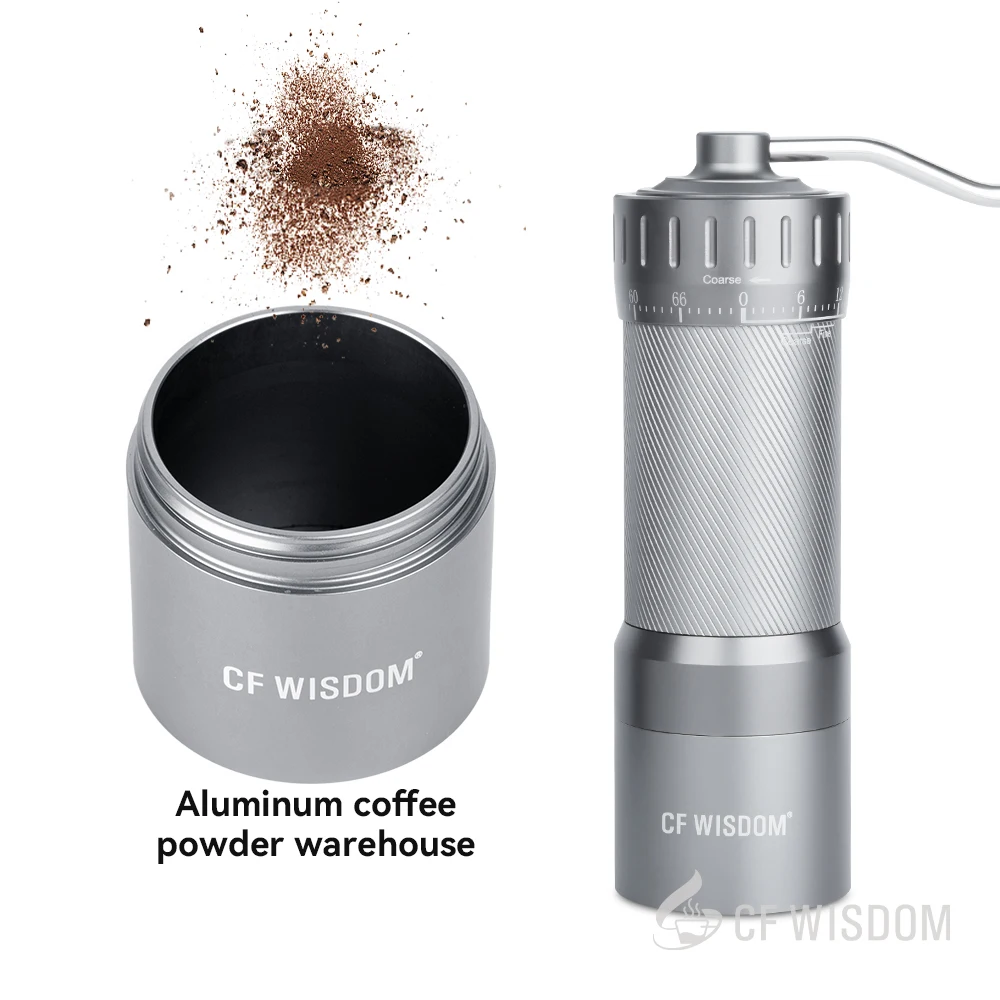
Selecting the optimal burr material depends largely on your specific circumstances and preferences. This practical guide will help match your needs with the right material:
For Casual Home Baristas (1-4 shots daily)
– Best Overall Option: Ceramic burrs
* Minimal heat generation benefits small batches
* Longer lifespan suits infrequent use
* Rich flavor profile complements traditional espresso blends
* More affordable entry point for quality grinding
- Premium Alternative: TiN-coated steel burrs
- Better consistency for those who frequently change beans
- Moderate price increase for significant performance gain
- Excellent balance of clarity and body
For Dedicated Enthusiasts (5-10 shots daily)
– Best Overall Option: TiN-coated burrs
* Durability matches increased usage
* Consistency supports experimentation with different beans
* Balanced flavor profile works well across various roast levels
* Reasonable price-to-performance ratio
- Premium Alternative: DLC-coated burrs
- Superior heat management during longer grinding sessions
- Enhanced flavor clarity for single-origin exploration
- Long-term value despite higher initial investment
For Small Cafés or Super-Enthusiasts
– Best Overall Option: DLC-coated burrs
* Exceptional consistency for commercial standards
* Minimal heat generation during extended use
* Superior flavor development, especially with specialty coffee
* Excellent long-term value despite higher initial cost
- Premium Alternative: Tungsten Carbide burrs
- Maximum durability for high-volume settings
- Ultimate precision for showcase espresso
- Lowest lifetime cost despite highest upfront investment
Special Considerations
– For Dark Roast Lovers: Ceramic burrs enhance body and chocolate notes
– For Light Roast Enthusiasts: DLC or premium steel preserve delicate acids and floral notes
– For Travelers: Ceramic offers durability and portability
– For Budget-Conscious: Quality steel burrs provide the best entry-level value
The decision ultimately comes down to balancing your coffee volume, flavor preferences, and budget. For most home users, the sweet spot lies in TiN-coated burrs, which offer an excellent compromise between performance and price.
For those seeking maximum precision without compromise, exploring high-precision manual grinders for espresso enthusiasts can reveal how premium burr materials translate to cup quality.
Optimizing Burr Performance: Maintenance for Longevity and Consistency
Even the finest burr material will underperform without proper maintenance. Following these material-specific maintenance protocols will maximize performance and lifespan:
For All Burr Types:
– Brush out grounds from burrs after each use
– Clean thoroughly every 1-2 weeks (or 1-2 lbs of coffee)
– Use grinder-specific cleaning products like Grindz monthly
– Store beans separately (not in the hopper) to reduce oils accumulation
Steel Burr Maintenance:
– Keep dry to prevent corrosion or rust
– Clean with a dry brush only; avoid water unless specifically stated by manufacturer
– Check for dullness by examining grounds (increasing fines indicates wear)
– Expected lifespan: Replace after 500-1500 pounds of coffee
Ceramic Burr Maintenance:
– Inspect regularly for chips or cracks
– Can be cleaned with water if thoroughly dried afterward
– Be extremely careful about foreign objects (can cause catastrophic failure)
– Expected lifespan: Replace after 1000-2000 pounds of coffee
Coated Burr Maintenance:
– Avoid metal tools when cleaning to prevent scratching the coating
– Use only recommended cleaning products (some may damage coatings)
– Watch for coating wear, visible as color changes or metal showing through
– Expected lifespan: Replace after 2000-5000 pounds (coating dependent)
Proper maintenance typically extends burr life by 30-50%, representing significant value. The comprehensive guide to extending burr lifespan suggests that consistency in maintenance matters more than occasional deep cleaning.
For optimal results, pair appropriate cleaning techniques with proper tools and techniques for proper burr maintenance. Simple wooden tools often work better than metal implements, which can damage precise burr edges.
Signs that replacement is needed include:
– Increasing grind time for the same amount of coffee
– More inconsistent particle size (visible as both powder and larger chunks)
– Declining flavor clarity despite using the same beans
– Need for increasingly finer settings to achieve proper flow rate
Frequently Asked Questions About Burr Materials for Espresso
Can I upgrade the burrs in my existing grinder?
Some grinders allow burr replacement or upgrades, but compatibility varies by manufacturer. Entry-level grinders rarely accept premium burrs, while prosumer models often accommodate aftermarket options. Consult your manufacturer before purchasing replacement burrs.
Do ceramic burrs really last longer than steel?
Yes, under normal use, ceramic burrs typically last 2-3 times longer than standard steel burrs. However, they’re more vulnerable to catastrophic damage from foreign objects like stones. The durability differences between grinder materials show that proper cleaning and bean quality significantly impact longevity.
Will changing burr material actually make my espresso taste different?
Yes. Blind taste tests consistently show detectable differences between burr materials. Most noticeable are differences in clarity, body, and accent flavors. Steel tends to produce brighter, more acidic shots, while ceramic enhances body and sweetness.
Are coated burrs worth the extra cost?
For casual users making 1-2 espressos daily, probably not. For enthusiasts making 5+ shots daily or those seeking maximum flavor clarity, absolutely. The value proposition improves with usage volume as the cost-per-shot decreases significantly.
Do burrs need “seasoning” before optimal performance?
Yes. New burrs typically require grinding 5-10 pounds of coffee before reaching peak performance. This break-in period smooths microscopic manufacturing marks and establishes proper cutting geometry. Some enthusiasts use inexpensive beans specifically for this purpose.
How do flat and conical burrs interact with different materials?
Conical burrs typically generate less heat regardless of material, making them better suited for ceramic construction. Flat burrs often provide better consistency but generate more heat, making them ideal candidates for heat-resistant coatings like TiN and DLC.
Can I clean my burrs with water?
This depends entirely on the material. Ceramic burrs can be cleaned with water if thoroughly dried afterward. Steel burrs should avoid water contact unless specified by the manufacturer. Coated burrs vary by coating type – consult your user manual.
Beyond Materials: Other Factors That Influence Espresso Grind Quality
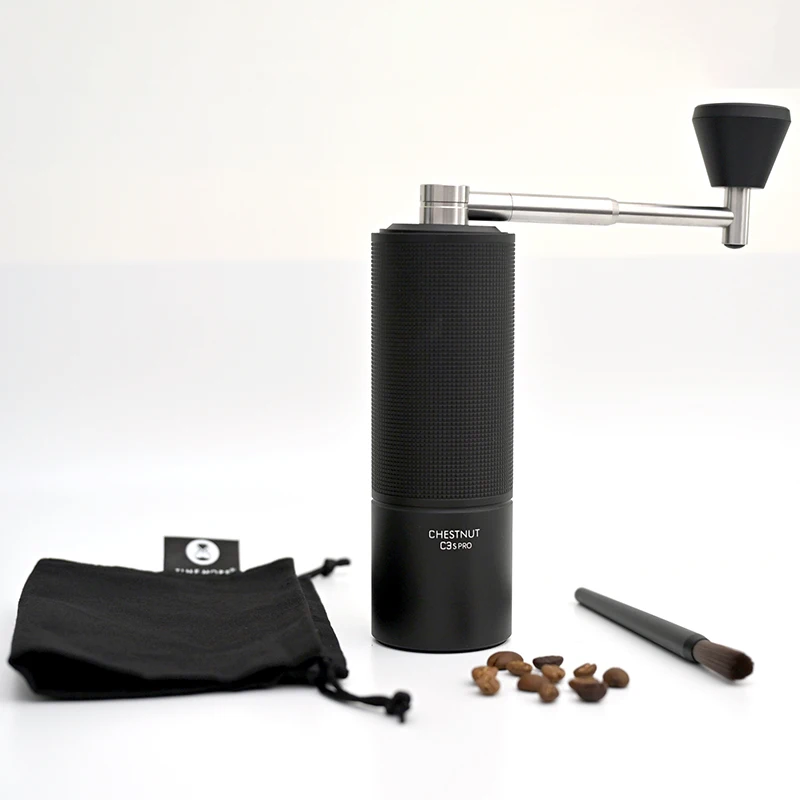
While burr material significantly impacts espresso quality, several other factors work in conjunction with material choice to determine overall performance:
Burr Alignment
Even premium materials underperform with poor alignment. Precision-aligned burrs should maintain tolerances within 10-30 microns, while budget grinders might have 100+ micron variances. This explains why some less expensive grinders with excellent alignment occasionally outperform pricier models with alignment issues.
The material impacts alignment sensitivity – ceramic burrs typically require more precise alignment due to their brittleness, while steel is somewhat more forgiving. Premium materials enhance performance only when properly aligned.
Motor Quality and Speed
Motor characteristics interact directly with burr materials:
– High-speed motors (1000+ RPM) generate more heat, making low-heat materials more valuable
– Lower-speed motors (400-800 RPM) produce less heat but may require sharper burr materials
– Motor consistency affects particle distribution regardless of burr material
Grind Retention
Different materials interact differently with coffee oils and static:
– Steel tends to build static, increasing retention
– Ceramic generates less static but has more surface irregularities
– Coated burrs typically have the lowest retention due to smooth surfaces and anti-static properties
Proper dosing and distribution techniques become even more important with higher-retention burr materials. The texture needed for espresso is affected not just by the burr’s cutting ability but also by how grounds exit the grinding chamber.
At Savor Suite, we carefully evaluate these factors alongside material quality when selecting our premium manual grinders. The interaction between material, design, and alignment determines whether a grinder will produce the consistent, precise grinding essential for exceptional espresso.

